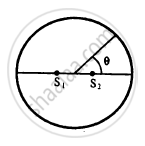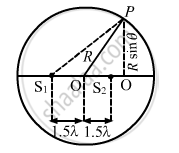Advertisements
Advertisements
प्रश्न
Figure shown two coherent sources S1 and S2 which emit sound of wavelength λ in phase. The separation between the sources is 3λ. A circular wire of large radius is placed in such way that S1,S2 is at the centre of the wire. Find the angular positions θ on the wire for which constructive interference takes place.

उत्तर
Let the sound waves from the two coherent sources S1 and S2 reach the point P.

rework
OQ = R cosθ
OP = R cosθ
OS2 = OS1 = 1.5\[\lambda\]
From the figure, we find that:
\[P {S_1}^2 = P Q^2 + Q S^2 = \left( R\sin\theta \right)^2 + \left( R\cos\theta - 1 . 5\lambda \right)^2\]
\[P {S_1}^2 = P Q^2 + Q {S_1}^2 = \left( R\sin\theta \right)^2 + \left( R\cos\theta + 1 . 5\lambda \right)^2\]
Path difference between the sound waves reaching point P is given by:
\[\left( S_1 P \right)^2 - \left( S_2 P \right)^2 = \left[ \left( R\sin\theta \right)^2 + \left( R\cos\theta + 1 . 5\lambda \right)^2 \right] - \left[ \left( R\sin\theta \right)^2 + \left( R\cos\theta - 1 . 5\lambda \right)^2 \right]\]
\[ = \left( 1 . 5\lambda + R\cos\theta \right)^2 - \left( R\cos\theta - 1 . 5\lambda \right)^2 \]
\[ = 6\lambda R\cos\theta\]
\[\left( S_1 P - S_2 P \right) = \frac{6\lambda R \cos\theta}{2R}\]
\[ = 3\lambda \cos\theta\]
Suppose, for constructive interference, this path difference be made equal to the integral multiple of \[\lambda\] .
Hence ,
\[\left( S_1 P - S_2 P \right) = 3\lambda \cos\theta = n\lambda\]
\[ \Rightarrow \cos\theta = \frac{n}{3}\]
\[ \Rightarrow \theta = \cos^{- 1} \left( \frac{n}{3} \right)\]
where, n = 0, 1, 2, ...
⇒ θ = 0°, 48.2°, 70.5°and 90° are similar points in other quadrants.
APPEARS IN
संबंधित प्रश्न
The equation \[y = A \sin^2 \left( kx - \omega t \right)\]
represents a wave motion with
If you are walking on the moon, can you hear the sound of stones cracking behind you? Can you hear the sound of your own footsteps?
Can you hear your own words if you are standing in a perfect vacuum? Can you hear your friend in the same conditions?
The voice of a person, who has inhaled helium, has a remarkably high pitch. Explain on the basis of resonant vibration of vocal cord filled with air and with helium.
When we clap our hands, the sound produced is best described by Here p denotes the change in pressure from the equilibrium value.
When two waves with same frequency and constant phase difference interfere,
A listener is at rest with respect to the source of sound. A wind starts blowing along the line joining the source and the observer. Which of the following quantities do not change?
(a) Frequency
(b) Velocity of sound
(c) Wavelength
(d) Time period
The sound level at a point 5.0 m away from a point source is 40 dB. What will be the level at a point 50 m away from the source?
A string, fixed at both ends, vibrates in a resonant mode with a separation of 2⋅0 cm between the consecutive nodes. For the next higher resonant frequency, this separation is reduced to 1⋅6 cm. Find the length of the string.
The two sources of sound, S1 and S2, emitting waves of equal wavelength 20.0 cm, are placed with a separation of 20.0 cm between them. A detector can be moved on a line parallel to S1 S2 and at a distance of 20.0 cm from it. Initially, the detector is equidistant from the two sources. Assuming that the waves emitted by the sources are in detector should be shifted to detect a minimum of sound.
Two sources of sound S1 and S2 vibrate at same frequency and are in phase. The intensity of sound detected at a point P as shown in the figure is I0. (a) If θ equals 45°, what will be the intensity of sound detected at this point if one of the sources is switched off? (b) What will be the answer of the previous part if θ = 60°?

In a standing wave pattern in a vibrating air column, nodes are formed at a distance of 4.0 cm. If the speed of sound in air is 328 m s−1, what is the frequency of the source?
The fundamental frequency of a closed pipe is 293 Hz when the air in it is a temperature of 20°C. What will be its fundamental frequency when the temperature changes to 22°C?
A tuning fork of frequency 256 Hz produces 4 beats per second with a wire of length 25 cm vibrating in its fundamental mode. The beat frequency decreases when the length is slightly shortened. What could be the minimum length by which the wire we shortened so that it produces no beats with the tuning fork?
Two electric trains run at the same speed of 72 km h−1 along the same track and in the same direction with separation of 2.4 km between them. The two trains simultaneously sound brief whistles. A person is situated at a perpendicular distance of 500 m from the track and is equidistant from the two trains at the instant of the whistling. If both the whistles were at 500 Hz and the speed of sound in air is 340 m s−1, find the frequencies heard by the person.
A boy riding on his bike is going towards east at a speed of 4√2 m s−1. At a certain point he produces a sound pulse of frequency 1650 Hz that travels in air at a speed of 334 m s−1. A second boy stands on the ground 45° south of east from his. Find the frequency of the pulse as received by the second boy.
A boy riding on a bicycle going at 12 km h−1 towards a vertical wall whistles at his dog on the ground. If the frequency of the whistle is 1600 Hz and the speed of sound in air is 330 m s−1, find (a) the frequency of the whistle as received by the wall (b) the frequency of the reflected whistle as received by the boy.
The speed of a wave in a string is 20 m/s and the frequency is 50 Hz. The phase difference between two points on the string 10 cm apart will be ______.
In the wave equation
`y = 0.5sin (2pi)/lambda(400t - x)m`
the velocity of the wave will be ______.
